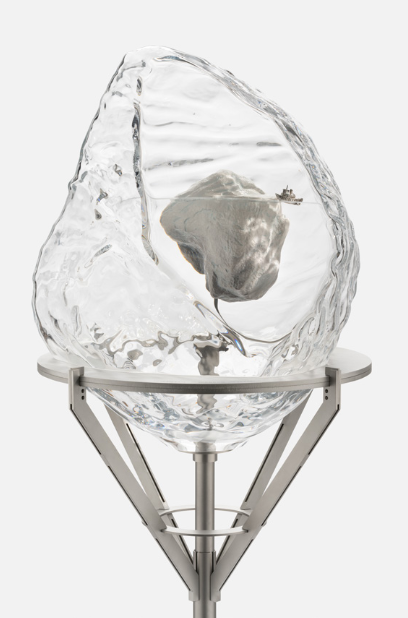
HOW BIG IS AN ICEBERG?
Have you ever heard the expression “it is just the tip of the iceberg“? It means that far the greatest part of the iceberg is hidden below the surface.
In fact only 10% is above water.

What can the expression “it is just the tip of the iceberg” also mean?
Icebergs from Sermeq Kujalleq can become 900 metres tall.
Try comparing that with other tall objects. You could use the Internet.
What do you think when you see this picture (pp.28-29)?
When the iceberg floats through the Icefjord it melts from below. It changes form and loses the balance.
What do you see in the video on this page? It is in the black square.
Why can icebergs float?
On page 31 are three models showing an iceberg breaking from the glacier. Do they also show the iceberg flipping over? Explain.
The largest Greenlandic icebergs take three to four years to melt. Before they melt completely they drift far into the ocean.

Rekonstruktion af Titanics forlis. Filmen er på engelsk.
On the map (page 32) you see the journey of the icebergs from Greenland. What do the numbers at the icebergs indicate?
What are the blue lines going horisontically and vertically?
Explain the dotted lines with small arrows on the map.
Have you ever heard the expression “it is just the tip of the iceberg“? It means that far the greatest part of the iceberg is hidden below the surface.
In fact only 10% is above water.

What can the expression “it is just the tip of the iceberg” also mean?
Icebergs from Sermeq Kujalleq can become 900 metres tall.
Try comparing that with other tall objects. You could use the Internet.
What do you think when you see this picture (pp.28-29)?
When the iceberg floats through the Icefjord it melts from below. It changes form and loses the balance.
What do you see in the video on this page? It is in the black square.
Why can icebergs float?
On page 31 are three models showing an iceberg breaking from the glacier. Do they also show the iceberg flipping over? Explain.
The largest Greenlandic icebergs take three to four years to melt. Before they melt completely they drift far into the ocean.

Rekonstruktion af Titanics forlis. Filmen er på engelsk.
On the map (page 32) you see the journey of the icebergs from Greenland. What do the numbers at the icebergs indicate?
What are the blue lines going horisontically and vertically?
Explain the dotted lines with small arrows on the map.




